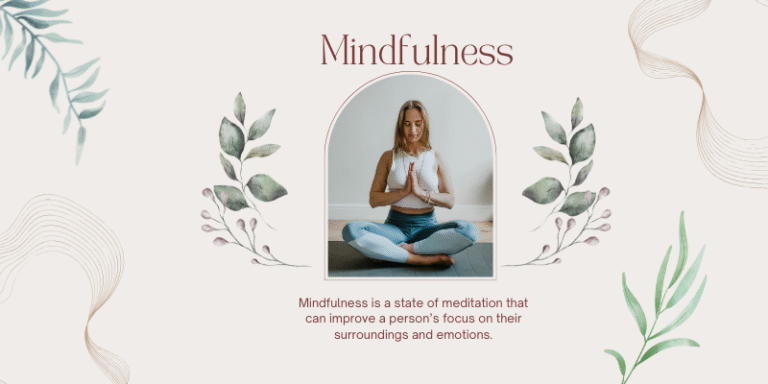Mindfulness is a mental practice with ancient roots in Buddhist traditions, now widely recognised and applied in modern psychological and healthcare settings. At its core, mindfulness is the practice of being fully present and engaged in the current moment, without judgement or attachment to thoughts or emotions (Kabat-Zinn, 1994). Rather than getting caught up in worries about the past or future, mindfulness teaches us to return our attention to the here and now—our breath, our bodily sensations, the environment, and our inner experiences.
What Is Mindfulness?
Mindfulness involves paying purposeful attention to the present moment, while calmly acknowledging and accepting one’s feelings, thoughts, and bodily sensations. According to Kabat-Zinn (1994), a leading figure in bringing mindfulness into Western medicine, mindfulness can be defined as “paying attention in a particular way: on purpose, in the present moment, and non-judgementally.”
This kind of attentiveness means not simply observing what is happening around and inside us, but doing so with an open and accepting attitude. Hofmann et al. (2010) note that mindfulness requires cultivating awareness without reacting to or being overwhelmed by the content of our experiences. Whether it is a distressing thought, a physical discomfort, or a pleasant sensation, mindfulness encourages us to observe it and let it pass without clinging to or rejecting it.
How to Practise Mindfulness
Mindfulness can be cultivated through various techniques, many of which are simple and accessible. These include:
- Meditation: Sitting quietly and focusing on the breath or bodily sensations is one of the most common ways to develop mindfulness. When the mind wanders, the practice is to gently bring it back to the breath or chosen focus point (Chiesa & Malinowski, 2011).
- Breathing exercises: Deep, conscious breathing helps anchor attention and calm the nervous system. It can be practised almost anywhere and at any time.
- Mindful movement: Yoga, tai chi, and walking meditation blend physical movement with awareness. Focusing on how the body moves can enhance both physical and mental presence (Baer et al., 2006).
- Daily life mindfulness: This means bringing mindfulness into routine activities like eating, washing dishes, or listening to someone. It involves paying attention to what is happening in the moment, such as the taste of food or the tone of a friend’s voice.
Williams and Penman (2011) offer a practical example: noticing the feel of a banister as one walks up the stairs. Such simple awareness moments cultivate a habit of being grounded in the now. Even minor changes—like sitting in a different seat or trying a new route to work—can help break habitual thinking and encourage fresh engagement with the world (Kabat-Zinn, 2005).
Why Is Mindfulness Important?
Modern life is often characterised by busyness, multitasking, and information overload. We may frequently ruminate about the past or worry about the future. This constant mental noise contributes to stress, anxiety, and a sense of disconnection. Mindfulness offers a powerful counterbalance by grounding us in the present.
One key aspect of mindfulness is learning to free oneself—at least temporarily—from the weight of past regrets and future worries. Kabat-Zinn (2003) describes this as an essential part of mental clarity: letting go of the “autopilot” mode that so many of us operate on and choosing to be in the moment.
Scientific Benefits of Mindfulness
Research in psychology and neuroscience supports a wide range of benefits associated with regular mindfulness practice. According to Hofmann et al. (2010), mindfulness-based therapy significantly reduces symptoms of anxiety and depression. Their meta-analysis found that participants who engaged in mindfulness training reported improved emotional regulation and greater resilience in stressful situations.
Similarly, Baer et al. (2006) suggest that mindfulness enhances several mental faculties, including attention, awareness, and acceptance. These improvements translate to better focus, reduced emotional reactivity, and a stronger sense of overall well-being.
In educational settings, students who practise mindfulness have shown improved concentration and memory, as well as lower levels of test anxiety. In the workplace, mindfulness can lead to better productivity, improved job satisfaction, and reduced burnout. Even short periods of mindfulness practice—such as a ten-minute breathing exercise or a mindful walk—can improve mood and cognitive performance (Chiesa & Malinowski, 2011).
Mindfulness and Physical Health
Mindfulness does not only benefit the mind; it has positive effects on the body as well. Studies suggest that mindfulness can lower blood pressure, improve sleep quality, and even enhance immune function (Baer et al., 2006). This is partly due to its influence on the autonomic nervous system, helping to reduce the physiological impact of stress.
Practising mindfulness may also encourage healthier lifestyle choices. By increasing self-awareness and reducing impulsive behaviours, individuals become more attuned to their bodies and more likely to engage in regular exercise, eat mindfully, and avoid harmful habits such as smoking or excessive drinking.
Incorporating Mindfulness into Everyday Life
Developing a consistent mindfulness practice does not require major life changes. It can start with small steps:
- Take five minutes each day to sit quietly and observe your breath.
- Choose one daily activity (e.g. brushing your teeth or drinking tea) to do mindfully.
- Use moments of waiting (e.g. in a queue or at a red light) as reminders to come back to the present.
- When walking, feel the contact of your feet with the ground and the rhythm of your breath.
- During conversations, listen fully instead of planning your next comment.
As Williams and Penman (2011) highlight, formal mindfulness practice—such as meditating on your morning commute or taking a mindful walk at lunch—can be deeply restorative. These moments help create a buffer against daily stressors and improve emotional balance.
Mindfulness is a powerful and accessible tool for enhancing mental clarity, reducing stress, and improving overall well-being. Rooted in ancient wisdom and supported by modern science, it offers a simple yet profound way of reconnecting with the present moment. Whether through formal meditation or everyday awareness, cultivating mindfulness can help individuals feel calmer, think clearer, and live more fully.
For those seeking to reduce anxiety, cope better with life’s demands, or simply find greater joy in everyday experiences, mindfulness provides a pathway toward greater self-awareness and emotional health.
References
Baer, R. A., Smith, G. T., Hopkins, J., Krietemeyer, J. and Toney, L., 2006. Using self-report assessment methods to explore facets of mindfulness. Assessment, 13(1), pp.27–45.
Chiesa, A. and Malinowski, P., 2011. Mindfulness-based approaches: Are they all the same? Journal of Clinical Psychology, 67(4), pp.404–424.
Hofmann, S. G., Sawyer, A. T., Witt, A. A. and Oh, D., 2010. The effect of mindfulness-based therapy on anxiety and depression: A meta-analytic review. Journal of Consulting and Clinical Psychology, 78(2), pp.169–183.
Kabat-Zinn, J., 1994. Wherever you go, there you are: Mindfulness meditation in everyday life. New York: Hyperion.
Kabat-Zinn, J., 2003. Mindfulness-based interventions in context: Past, present, and future. Clinical Psychology: Science and Practice, 10(2), pp.144–156.
Kabat-Zinn, J., 2005. Coming to our senses: Healing ourselves and the world through mindfulness. New York: Hachette Books.
Williams, M. and Penman, D., 2011. Mindfulness: An eight-week plan for finding peace in a frantic world. London: Rodale.









